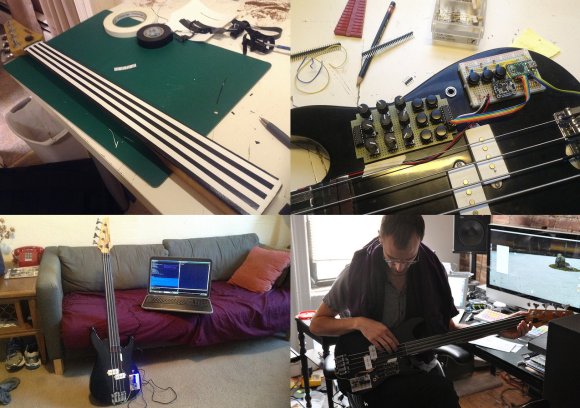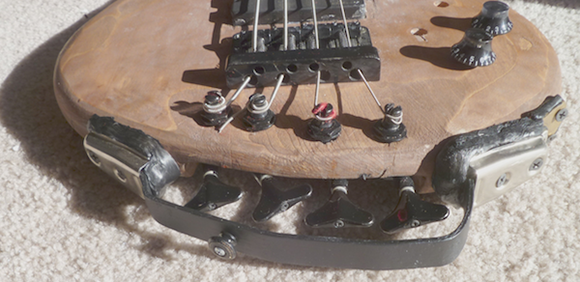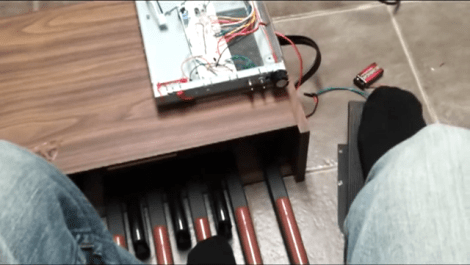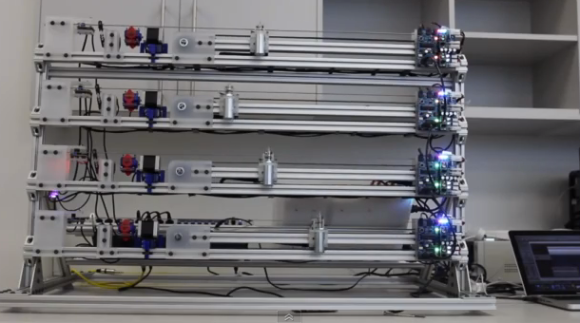Some things just go hand in hand. Hacking and guitars are one perfect example. A huge number of hackers, makers, and engineers have at least dabbled in playing the guitar. Even those who don’t play have heard the swan song of the wayward guitarist “Bro, you fix amps?”. Seriously, once your guitar toting friends find out you tinker in electronics, you’ll never be left wanting for pizza or beer. This week’s Hacklet is about some of the best guitar projects on Hackaday.io!
bass18 Articles
Parametric Spherical Speakers Are Not A Moon
A good speaker enclosure is not just about building a box out of plywood and covering it with carpet, although playing with 1F capacitors is pretty cool. No, for a good speaker enclosure you need the right internal volume, the right size bass port, the right speaker, and it should definitely, certainly, not be a moon. [Rich] figured out he could do all of this with a 3D printer, resulting in the NOMOON: The NOMOON Orbital Music-Making Opensource, Openscad-generated Nihilator.
This work is a continuation of earlier work that designed parameterized speakers in the shape of Borg cubes. Now [Rich] is on to Borg scout ships, and this version has everything you would expect for speaker design.
The NOMOON is available on the Thingiverse Customizer with variables for the internal diameter, the volume of the enclosure in liters, wall thickness, speaker hole, bass port, and wire holes. Of course a customized design is also possible with a stock OpenSCAD installation.
[Rich] has printed a few of these not moons and even with a speaker with terrible bass response, he has a pretty good-sounding setup as far as Youtube videos go. You can check that out below.
Continue reading “Parametric Spherical Speakers Are Not A Moon”
Rock Out With Your Ribbon Controller Bass

[Brendan Byrne] stripped this instrument down to basics and built himself a ribbon controller bass guitar. Details are still a bit sparse on his website, but there are plenty of detailed pictures on his flickr stream. [Brendan] built his bass as part the Future of Guitar Design Course at Parsons the New School for Design. His goal was to create an experience in which playing the instrument and altering parameters of effects are triggered by the same gestures. He’s definitely succeeded in that effort.
Basically, the bass is a four channel ribbon controller. The frets were removed to make way for four graphite strips. [Brendan] followed [Iain’s] excellent tutorial to create his own graphite strips using soft artist’s pencils. The ribbons essentially become potentiometers, which are then read by a teensy. [Brendan] expanded the instrument’s sonic palette by adding several buttons and potentiometers mapped to MIDI control codes. He even included a triple axis accelerometer so every movement of the bass can be mapped. The MIDI data is sent to a PC running commercial music software. Analog sound comes from a piezo pickup placed under the bridge of the bass.
The results are pretty awesome. While we can’t say [Brendan’s] demo was music to our ears, we definitely see the musical possibilities of this kind of instrument.
Continue reading “Rock Out With Your Ribbon Controller Bass”
Turning A Broken Bass Into A Headless Bass

A while back [Michael] inherited a broken bass guitar from a friend. The headstock for this bass was cracked right down the middle, and the friend attempted a repair with a bolt and a couple of washers. After trying to figure out what the addition of a bolt was trying to accomplish, [Michael] set to work repairing this bass and ended up doing a headless conversion.
A headless bass, just as the name implies, does away with the headstock and moves the tuners to the other side of the guitar – in [Michael]’s case, right below the bridge. After sawing off the broken headstock above the truss rod, [Michael] made a string retainer and bolted it on to the remainder of the neck.
The tuners had to be moved, of course, so [Michael] routed out a section of the body below the bridge. Four holes were drilled and the original tuners slipped right in. The result is a perfectly functional bass that would fit right in to the tour van of an 80’s metal band.
You can check out [Michael]’s bass down in the pocket.
Continue reading “Turning A Broken Bass Into A Headless Bass”
MechBass: A Robotic Bass Guitar That Sounds Fantastic
[James] wrote in to show us his honors project for his fourth year at Victoria University of Wellington. He designed and built this robotic bass guitar. You can hear it performing “mass hysteria” by the band Muse after the break. It sounds great, but we’d love to hear it without the full accompaniment.
[James] doesn’t have a site up for the MechBass, so we’ve included details below.
Continue reading “MechBass: A Robotic Bass Guitar That Sounds Fantastic”
BaceMaker Weds Organ Foot Pedals With Guitar Whammy Effects

[Jon Ferwerda] managed to fry the analog electronics on an old electric organ while conducting some circuit bending experiments. It’s a loss, but he’s still left with some cool equipment to play with. Recently he got to work generating tones using the organ’s foot pedals.
There were two types of foot pedal included with this organ, the set that is arranged like a keyboard, and a rocker pedal similar to what you might use with an electric sewing machine. Since the music generation was handled by those fried bits of organ [Jon] got to work interfacing the foot keyboard with a 555 timer. He used a fairly large capacitor to get the frequency into the bass range and wired individual pedals to different parts of a resistor network. But he didn’t stop with that. The rocker pedal has its own variable resistor hardware which lets him bend the pitches are they are being generated which sounds alike like a guitar whammy effect. He shows his work in the clip after the break. We think he nailed it! This is a perfect supplement to any type of electronic music setup.
Continue reading “BaceMaker Weds Organ Foot Pedals With Guitar Whammy Effects”
[Jeri Ellsworth] On Making Her C64 Bass Keytar

[Jeri Ellsworth] finally set aside some time to talk about the build process for her Commodore 64 bass keytar. We think what started by taking a band saw to the guitar body ended up as a fantastic new instrument.
When she was showing off the project at Maker Faire we really only got a cursory look at what it could do. Her most recent video covers all that went into pulling off the project. Once the bulk of the guitar body was gone she tore the guts out of a dead c64 in order to mate the case with the guitar neck. Always the craftsman, she altered the computer’s badge to preserve the iconic look, then went to work adding pickups to each string using piezo sensors. This was done with Maker Faire in mind because magnetic pickups would have been unreliable around all of the tesla coils one might find at the event. These were amplified and filtered before being processed via an FPGA which connects to the original c64 SID 6581 chip.
Continue reading “[Jeri Ellsworth] On Making Her C64 Bass Keytar”













